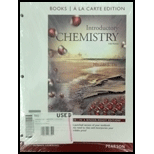
Interpretation:
For each of the given compounds, solubility product
Concept Introduction:
When an ionic compound dissolved in water it breaks into its constitute ions, water molecule has negative charge on oxygen molecule and positive charge on hydrogen atoms due difference in electronegativity between hydrogen and oxygen atom.
Solubility product have unit of concentration.
Solubility product
For the given chemical equation
Want to see the full answer?
Check out a sample textbook solution
Chapter 15 Solutions
Introductory Chemistry, Books a la Carte Edition (5th Edition)
- 12.109 Copper(II) iodate has a solubility of 0.136 g per 100 g of water. Calculate its molar solubility in water and its Ksp.arrow_forwardYou place 1.234 g of solid Ca(OH)2 in 1.00 L of pure water at 25 C. The pH of the solution is found to be 12.68. Estimate the value of Ksp for Ca(OH)2.arrow_forwardWrite the chemical equation for the formation of the Fe(CN)63 ion. Write the Kf expression.arrow_forward
- How many grams of Zn(CN)2(s) (117.44 g/mol) would be soluble in 100 mL of H2O? Include the balanced reaction and the expression for Ksp in your answer. The KSP value for Zn(CN)2(s) is 3.01016.arrow_forwardWhen 1.55 g of solid thallium(I) bromide is added to 1.00 L of water, the salt dissolves to a small extent. TlBr(s)Tl+(aq)+Br(aq) The thallium(I) and bromide ions in equilibrium with TlBr each have a concentration of 1.9 103 M. What is the value of Ksp for TlBr?arrow_forwardWrite the Ksp expression for each of these slightly soluble salts: CuBr HgI2 SrSO4arrow_forward
- The average normal concentration of Ca2+ in urine is 5.33 g/L. Calculate the concentration of oxalate needed to precipitate calcium oxalate to initiate formation of a kidney stone. Ksp of calcium oxalate = 2.3 × 10−9. Calculate the minimum phosphate concentration that would precipitate a calcium phosphate kidney stone. Ksp of calcium phosphate = 2.0 × 10−29.arrow_forwardBarium sulfate is a contrast agent for X-ray scans that are most often associated with the gastrointestinal tract. Calculate the mass of BaSO4 that can dissolve in 100.0 mL of solution. The Ksp value for BaSO4 is 1.5 109.arrow_forwardNitrate salts are generally considered to be soluble salts. One of the least soluble nitrate salts is barium nitrate. Approximately 15 g of Ba(NO3)2 will dissolve per liter of solution. Calculate Ksp the value for barium nitrate.arrow_forward
- Magnesium hydroxide, Mg(OH)2, is the active ingredient in die antacid TUMS and has a Ksp value of 8.9 1012. If a 10.0-g sample of Mg(OH)2 is placed in 500.0 mL of solution, calculate the moles of OH ions present. Because the Ksp value for Mg(OH)2 is much less than 1, not a lot of solid dissolves in solution. Explain how Mg(OH)2 works to neutralize large amounts of stomach acid.arrow_forwardConsider a 2.0-L aqueous solution of 4.17 M NH3, where 21.0 g of NH4Cl are dissolved. To this solution, 4.8 g of CaCl2 are added. (a) What is [OH-] before CaCl2 is added? (b) Will a precipitate form? (c) What is [Ca2+] after equilibrium is established?arrow_forwardYou have two salts, AgX and AgY, both with very similar Ksp values. You know that the Ka for HX is much greater than the Ka for HY. Which salt is more soluble in acidic solution? Explain.arrow_forward
 Chemistry by OpenStax (2015-05-04)ChemistryISBN:9781938168390Author:Klaus Theopold, Richard H Langley, Paul Flowers, William R. Robinson, Mark BlaserPublisher:OpenStax
Chemistry by OpenStax (2015-05-04)ChemistryISBN:9781938168390Author:Klaus Theopold, Richard H Langley, Paul Flowers, William R. Robinson, Mark BlaserPublisher:OpenStax General Chemistry - Standalone book (MindTap Cour...ChemistryISBN:9781305580343Author:Steven D. Gammon, Ebbing, Darrell Ebbing, Steven D., Darrell; Gammon, Darrell Ebbing; Steven D. Gammon, Darrell D.; Gammon, Ebbing; Steven D. Gammon; DarrellPublisher:Cengage Learning
General Chemistry - Standalone book (MindTap Cour...ChemistryISBN:9781305580343Author:Steven D. Gammon, Ebbing, Darrell Ebbing, Steven D., Darrell; Gammon, Darrell Ebbing; Steven D. Gammon, Darrell D.; Gammon, Ebbing; Steven D. Gammon; DarrellPublisher:Cengage Learning Chemistry & Chemical ReactivityChemistryISBN:9781133949640Author:John C. Kotz, Paul M. Treichel, John Townsend, David TreichelPublisher:Cengage Learning
Chemistry & Chemical ReactivityChemistryISBN:9781133949640Author:John C. Kotz, Paul M. Treichel, John Townsend, David TreichelPublisher:Cengage Learning Chemistry: The Molecular ScienceChemistryISBN:9781285199047Author:John W. Moore, Conrad L. StanitskiPublisher:Cengage Learning
Chemistry: The Molecular ScienceChemistryISBN:9781285199047Author:John W. Moore, Conrad L. StanitskiPublisher:Cengage Learning Chemistry for Engineering StudentsChemistryISBN:9781337398909Author:Lawrence S. Brown, Tom HolmePublisher:Cengage Learning
Chemistry for Engineering StudentsChemistryISBN:9781337398909Author:Lawrence S. Brown, Tom HolmePublisher:Cengage Learning Introductory Chemistry: A FoundationChemistryISBN:9781337399425Author:Steven S. Zumdahl, Donald J. DeCostePublisher:Cengage Learning
Introductory Chemistry: A FoundationChemistryISBN:9781337399425Author:Steven S. Zumdahl, Donald J. DeCostePublisher:Cengage Learning





